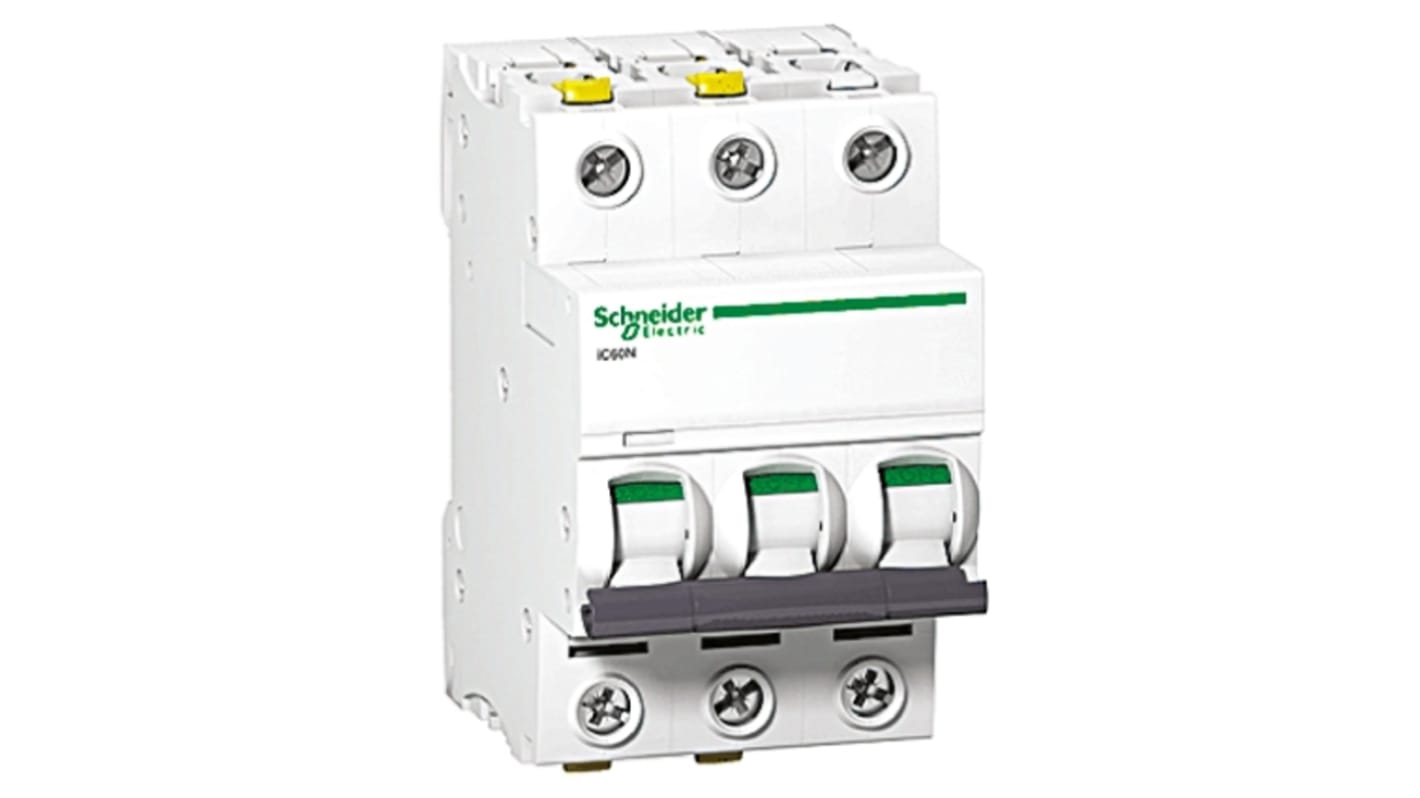Schneider Electric Acti 9 iC60H MCB, 3P, 2A Curve D, 440V AC, 100 → 133V DC, 10 kA Breaking Capacity
- RS Stock No.:
- 791-3559
- Mfr. Part No.:
- A9F55302
- Brand:
- Schneider Electric

Image representative of range
Subtotal (1 unit)*
£148.33
(exc. VAT)
£178.00
(inc. VAT)
FREE delivery for orders over £50.00
- 8 unit(s) ready to ship
Units | Per unit |
|---|---|
| 1 + | £148.33 |
*price indicative
Better World
Our Better World range features products that make it easy for you to make a greener product choice you can trust. Click here to find out more.
- RS Stock No.:
- 791-3559
- Mfr. Part No.:
- A9F55302
- Brand:
- Schneider Electric
Select all | Attribute | Value |
|---|---|---|
| Brand | Schneider Electric | |
| Number of Poles | 3 | |
| Current Rating | 2A | |
| Tripping Characteristics | Type D | |
| Rated AC Voltage | 440 V, 12 → 133 V, 220 → 240 V, 380 → 415V | |
| Rated DC Voltage | 100 → 133V | |
| Breaking Capacity at Maximum Voltage Rating | 10 kA | |
| Range | Acti 9 | |
| Series | iC60H | |
| Circuit Breaker Type | MCB | |
| Width | 54mm | |
| Length | 85mm | |
| Mounting Style | DIN Rail Mount | |
| Depth | 78.5mm | |
| Better World Verification | Green Premium | |
| Better World Product | Yes | |
| Tripping Mechanism | Thermal-Magnetic | |
| Terminal Contact Type | Screw | |
| Reset Actuator Type | Rocker Switch | |
| Select all | ||
|---|---|---|
Brand Schneider Electric | ||
Number of Poles 3 | ||
Current Rating 2A | ||
Tripping Characteristics Type D | ||
Rated AC Voltage 440 V, 12 → 133 V, 220 → 240 V, 380 → 415V | ||
Rated DC Voltage 100 → 133V | ||
Breaking Capacity at Maximum Voltage Rating 10 kA | ||
Range Acti 9 | ||
Series iC60H | ||
Circuit Breaker Type MCB | ||
Width 54mm | ||
Length 85mm | ||
Mounting Style DIN Rail Mount | ||
Depth 78.5mm | ||
Better World Verification Green Premium | ||
Better World Product Yes | ||
Tripping Mechanism Thermal-Magnetic | ||
Terminal Contact Type Screw | ||
Reset Actuator Type Rocker Switch | ||
- COO (Country of Origin):
- BG
Schneider Electric Acti9 iC60H MCB Range
Benefits & Features
• Class-2 insulation: ensures continuous protection for both operators and unqualified persons.
• Insulated terminals (IP20)
• Highly durable with robust connections that provide twice the standard tightening torque
• Provide greater continuity of service thanks to VisiTrip
• Double clip for dismounting with comb busbar in place
What does a miniature circuit breaker do?
What are the differences in the Tripping Curves B, C, and D?
Applications: protection of generators, persons, very long cables
Curve C: Tripping: 5 to 10 times the rated current
Applications: protection of circuits and general applications
Curve D: Tripping: 10 to 14 times the rated current
Applications: protection of high surge circuits, welders, transformers and motors
Related links
- Schneider Electric Acti 9 iC60H MCB 2A Curve C 100 → 133V DC, 10 kA Breaking Capacity
- Schneider Electric Acti 9 iC60H MCB 2A Curve D 100 → 133V DC, 10 kA Breaking Capacity
- Schneider Electric Acti 9 iC60H MCB 50A Curve D 100 → 133V DC, 10 kA Breaking Capacity
- Schneider Electric Acti 9 iC60H MCB 4A Curve D 100 → 133V DC, 10 kA Breaking Capacity
- Schneider Electric Acti 9 iC60H MCB 6A Curve D 100 → 133V DC, 10 kA Breaking Capacity
- Schneider Electric Acti 9 iC60H MCB 63A Curve D 100 → 133V DC, 10 kA Breaking Capacity
- Schneider Electric Acti 9 iC60H MCB 25A Curve D 100 → 133V DC, 10 kA Breaking Capacity
- Schneider Electric Acti 9 iC60H MCB 16A Curve D 100 → 133V DC, 10 kA Breaking Capacity
